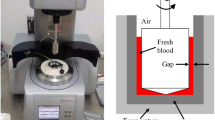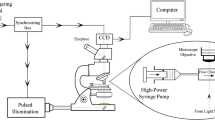Abstract
With the increasing use of artificial organs, blood damage has been raising ever more clinical concern. Blood trauma is in fact a major complication resulting from the implantation of medical devices and the use of life support apparatuses. Red blood cells damage predictive models furnish critical information on both the design and the evaluation of artificial organs, because their correct usage and implementation are thought to provide clear and rational guidance for the improvement of safety and efficacy. The currently adopted power-law shear-induced haemolysis prediction model lacks sensitivity with respect to the cumulative effect of previously applied stress magnitudes. An alternative model is proposed where a mechanical quantity was defined, able to describe the blood damage sustained by red cells under unsteady stress conditions, taking into account the load history. The proposed formulation predicted the same trend as the available experimental data. The obtained results have to be considered a preliminary validation of the basic hypothesis of this modified red blood cell damage prediction model. To date, the necessity to design further experiments to validate the proposed damage function clashes with the limitations inherent to current systems to get the time-varying shear stress completely under control.
Similar content being viewed by others
References
Apel J, Paul R, Klaus S, Siess T, Reul H (2001)Assessment of haemolysis related quantities in a microaxial blood pump by computational fluid dynamics. Artif Organs 5:341–347
Baldwin JT, Deutsch S, Geselowitz DB, Tarbell JM (1994) LDA Measurements of Mean Velocity and Reynolds Stress Fields within an Artificial Heart Ventricle. TRANS ASME- J Biomechanical Engineering 116:190–200
Barbaro V, Grigioni M, Daniele C, D’Avenio G (1998) Principal stress analysis in LDA measurement of the flow field downstream of 19-mm Sorin Bicarbon heart valve. Technol Health Care 6(4):259–270
Blackshear PL (1972a) Mechanical haemolysis in flowing blood. In: Fung YC (eds). Biomechanics Its foundation and objectives Englewood Cliffs. Prentice Hall Inc., NJ
Blackshear PL (1972b) Haemolysis at prosthetic surfaces. In: Hair MR (eds) Chemistry of biosurfaces. Marcel Dekker, New York
Blackshear PL, Blackshear GL (1987) Mechanical haemolysis. In: Skalak R, Chien S (eds) Handbook of bioengineering. McGraw-Hill, NewYork
Blackshear PL, Dorman FD, Steinbach JH (1965) Some mechanical effects that influence haemolysis. Trans Am Soc Artif Intern Organs 11:112
Bludszuweit C (1995) Three-dimensional numerical prediction of stress loading of blood particles in a centrifugal pump. Artif Organs 19(7):590–596
Bludszuweit C (1995) Model for a general mechanical blood damage prediction. Artif Organs 19(7):583–589
Bodnar E (1996) Editorial: the Medtronic Parallel™ valve and the lessons learned. J Heart Valve Dis 5:572–573
Burgreen GW, Antaki JF, Wu ZJ, Holmes AJ (2001) Computational fluid dynamics as a development tool for rotary blood pumps. Artif Organs 25(5):336–340
Chan WK, Wong YW, Ding Y, Chua LP, Yu SC (2002) Numerical investigation of the effect of blade geometry on blood trauma in a centrifugal blood pump. Artif Organs 26(9):785–793
De Wachter D, Verdonck P (2002) Numerical calculation of haemolysis levels in peripheral hemodialysis cannulas. Artif Organs 26(7):576–582
Ellis JT, Wick TM, Yoganathan AP (1998) Prosthesis-induced haemolysis: mechanisms and quantification of shear stress. J Heart Valve Dis 7:376–386
Giersiepen M, Wurzinger LJ, Opitz R, Reul H (1990) Estimation of shear stress related blood damage in heart valve prostheses: in vitro comparison of 25 aortic valves. Int J Artif Organs 13(5):300–306
Goubergrits L, Affeld K (2004) Numerical estimation of blood damage in artificial organs. Artif Organs 28(5):499–507
Grigioni M, Daniele C, D’Avenio G, Barbaro V (1999) A discussion on the threshold limit for haemolysis related to Reynolds shear stress. J Biomech 32(10):1107–1112
Grigioni M, Daniele C, Morbiducci U, Di Benedetto G, D’Avenio G, Barbaro V (2002) Mechanical blood trauma potential in vascular access devices: a comparison of case studies. Int J Artif Organs 25(9):882–891
Grigioni M, Daniele C, Morbiducci U, D’Avenio G, Di Benedetto G, Barbaro V (2004) The power-law mathematical model for blood damage prediction: analytical developments and physical inconsistencies. Artif Organs 28(5):467–475
Hansen JC, Skalak R, Chien S, Hoger A (1996) An elastic network model based on the structure of the red blood cell membrane skeleton. Biophys J 70(1):146–166
Kameneva MV, Marad PF, Brugger JM, Repko BM, Wang JH, Moran J, Borovetz HS (2002) In vitro evaluation of haemolysis and sublethal blood trauma in a novel subcutaneous vascular access system for hemodialysis. ASAIO Journal 48(1):34–38
Kameneva MV, Burgreen GW, Kono K, Repko B, Antaki JF, Umezu M (2004) Effects of turbulent stresses on mechanical hemolysis: experimental and computational analysis. ASAIO J 50:418–423
Klaus S, Korfer S, Mottaghy K, Reul H, Glasmacher B (2002) In vitro blood damage by high shear flow: human versus porcine blood. Int J Artif Organs 25(4):306–312
Klaus S, Korfer S, Mottaghy K, Reul H, Glasmacher B (2003) Blood traumatization by time varying high shear stresses: investigations with a new model system. Int J Artif Organs 26(7):635
Kuypers FA (1998) Red cell membrane damage. J Heart Valve Dis 7(4):387–395
Leverett LB, Hellums JD, Alfrey CP, Lynch BC (1972) Red blood cell damage by shear stress. Biophysical Journal 12:257–273
Lim WL, Chew YT, Chew TC, Low HT (2001) Pulsatile flow studies of a porcine bioprosthetic aortic valve in vitro: PIV measurements and shear-induced blood damage. J Biomech 34:1417–1427
Lu PC, Lai HC, Liu JS (2001) A reevaluation and discussion on the threshold limit for haemolysis in a turbulent shear flow. J Biomech 34(10):1361–1364
Maraj R, Jacobs LE, Ioli A, Kotler MN (1998) Evaluation of haemolysis in patients with prosthetic heart valves. Clin Cardiol 21:387–92
Mohandas N, Clark MR, Jacobs MS, Shohet SB (1980) Analysis of factors regulating erythrocyte deformability. J Clin Invest 66(3): 563–573
Mohandas N, Chasis JA, Shohet SB (1983) The influence of membrane skeleton on red cell deformability, membrane material properties, and shape. Semin Hematol 20(3):225–242
Paul R, Apel J, Klaus S, Schugner F, Schwindke P, Reul H (2003) Shear stress related blood damage in laminar couette flow. Artif Organs 27(6):517–529
Richardson E (1975) Applications of a theoretical model for haemolysis in shear flow. Biorheology 12:27–37
Sallam AM, Hwang NHC (1984) Human red blood cell haemolysis in a turbulent shear flow: contribution of Reynolds shear stresses. Biorheology 21:783–797
Schima H, Wieselthaler G (1995) Mechanically induced blood trauma: are the relevant questions already solved, or is it still an important field to be investigated? Artif Organs 19(7):563–564
Schima H, Muller MR, Tsangaris S, Gheiseder G, Schlusche C, Losert U, Thoma H, Wolner E (1993) Mechanical blood traumatization by tubing and throttles in in vitro pump tests: experimental results and implications for haemolysis theory. Artif Organs 17(3):164–170
Song X, Throckmorton AL, Wood HG, Antaki JF, Olsen DB (2003) Computational fluid dynamics prediction of blood damage in a centrifugal pump. Artif Organs 27(10):938–941
Steegers A, Paul R, Reul H, Rau G (1999) Leakage flow at mechanical heart valve prostheses: improved washout or increased blood damage?. J Heart Valve Dis 8(3):312–323
Yano T, Sekine K, Mitoh A, Mitamura Y, Okamoto E, Kim DW, Nishimura I, Murabayashi S, Yozu R (2003) An estimation method of haemolysis within an axial flow blood pump by computational fluid dynamics analysis. Artif Organs 27(10):920–925
Yeleswarapu KK, Antaki JF, Kameneva MV, Rajagopal KR (1995) A mathematical model for shear-induced haemolysis. Artif Organs 19(7):576–582
Yobobori T (1968) An interdisciplinary approach to fracture and strenght of solids. Wolters-Noordhoff Scientific Publications Ltd, Groningen
Zimmer R, Steegers A, Paul R, Affeld K, Reul H (2000) Velocities, shear stresses and blood damage potential of the leakage jets of the Medtronic Parallel bileaflet valve. Int J Artif Organs 23:41–48
Author information
Authors and Affiliations
Corresponding author
Rights and permissions
About this article
Cite this article
Grigioni, M., Morbiducci, U., D’Avenio, G. et al. A novel formulation for blood trauma prediction by a modified power-law mathematical model. Biomech Model Mechanobiol 4, 249–260 (2005). https://doi.org/10.1007/s10237-005-0005-y
Received:
Accepted:
Published:
Issue Date:
DOI: https://doi.org/10.1007/s10237-005-0005-y




